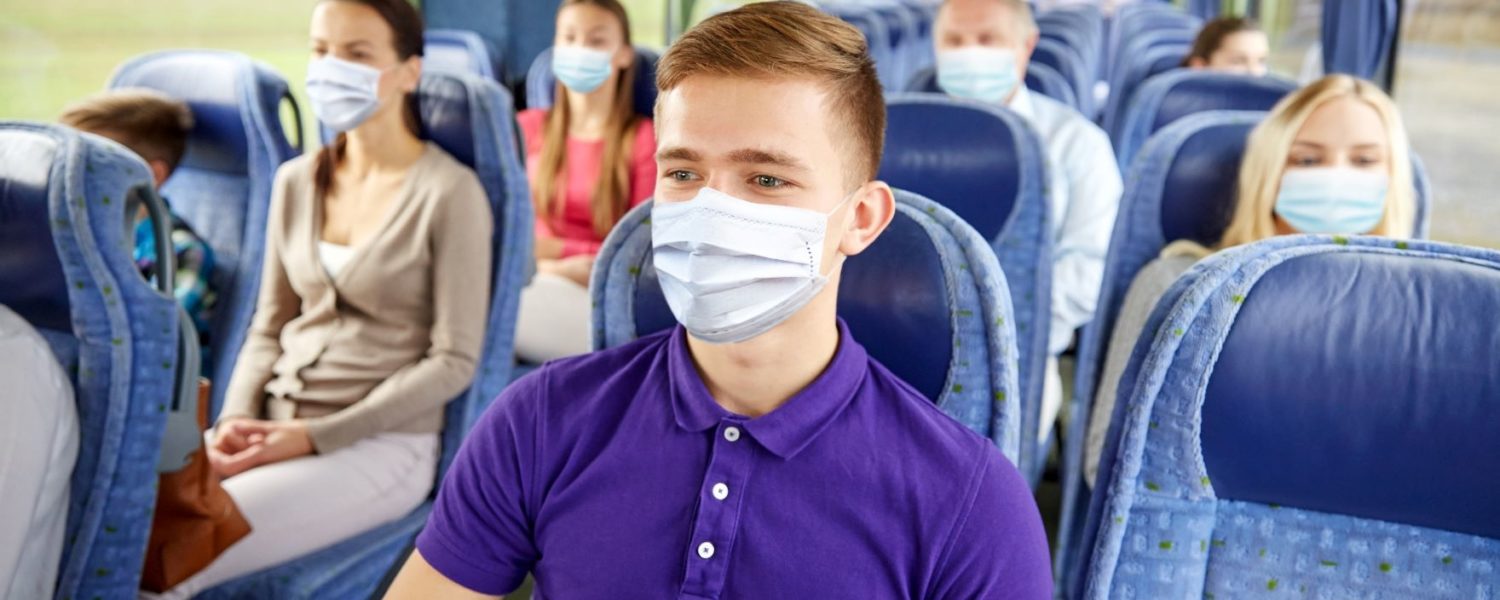It has never been more important to diligently clean and sanitize your church buses than it is today. It is easy to remember to clean surfaces, yet we often forget about the larger issue: the cabin air. The tiniest particles of viruses and bacteria remain suspended in the air for a long time and are easily inhaled, yet much of the focus has been on surface cleaning, until now.
There is still a lot we do not know about the coronavirus, which makes it even more of a challenge to disinfect buses. These tips for sanitizing your church bus interior will help protect your congregation from catching viruses and passing along germs.
As soon as anyone steps onto the bus, they bring with them bacteria and viruses that pass onto the surfaces and into the air. A combination of air sanitization and surface cleaning offers the most effective solution.
According to organizations such as the World Health Organization and the CDC, COVID-19 is primarily spread through droplets generated when an infected person coughs, sneezes, or speaks.
You can also become infected by touching a contaminated surface when these droplets land on surfaces and then touch your eyes, nose or mouth. The approach to keeping passengers safe should ideally focus on three things: sanitizing the air, preventing the spread, and cleaning surfaces of your buses.
Organizations such as the CDC have outlined guidelines for cleaning buses during the pandemic. Here are some of their tips for sanitizing your church buses thoroughly.
- SANITIZE THE AIR
Disinfecting surfaces and foggers do not give full protection against virus transmission. Combining air decontamination in addition to foggers and surface disinfection gives your bus the ultimate protection and safety against viruses that are primarily spread through the air.
Have an Air Sanitizing System Installed
Find a system that utilizes the latest in air disinfection and cleaning technologies. Avoid ceiling-mounted systems that pull the cabin air upward, allowing live germs and viruses to hover at face level for long periods of time. Instead, find an air sanitizer like the O2 Fresh Technology System, which pulls the cabin air from the floor and dispenses fresh air into the ceiling.
You’ll also want to make sure the system you choose uses multiple levels of filtration that include HEPA filters. The combination traps and destroys allergens, mold, germs, and viruses, helping to create a safer traveling environment. The system should always incorporate a certain spectrum of UV light that constantly exposes the air as it is refreshed through the system that is concealed from passengers.
- PREVENTING SPREAD
Promote Healthy Hygiene Practices
Reducing germs in your buses starts with good hygiene. Ensure you have enough supplies for people to clean their hands. Supplies include hand sanitizer, disposable disinfecting wipes, 60% alcohol or higher disinfectant sprays, and tissues and/or paper towels to blow noses and cover coughs. These are important tools to sanitize hands between washing.
Keep Your Distance
Wherever possible, passengers should spread out to reduce droplet and airborne transmission.
Mask Up for Safety
Masks can reduce the rate of virus transmission. Masks offer some protection to the wearer and are also meant to protect other people in case the wearer is unknowingly infected with the virus that causes COVID-19. Note: Masks should not be placed on children younger than 2 years old, anyone who has trouble breathing or is unconscious, and anyone who is incapacitated or otherwise unable to remove the mask without assistance.
- DISINFECT SURFACES
Clean More Frequently
If buses are used several times a day, add more frequent, detailed disinfection at regular intervals and spot clean soil and stains. Additional staffing may be in order.
Choose Products That Are Safe
When choosing cleaning products, keep these two considerations in mind:
- The product must be safe and effective for the persons applying it and the passengers on the bus.
- It must also be safe and appropriate for the surfaces found on your bus. You should check to ensure that disinfectants or cleaners are compatible and will not damage your vehicle surfaces, like cloth upholstery, carpet, vinyl, or plastics commonly used in vehicle interiors. If you are unsure about how to clean your bus properly, refer to your vehicle manual. Contact the parts & service department of a reputable dealer who can advise you on what cleaners may be compatible with typical surfaces in vehicles.
Always rely on the safety data sheet for each cleaning product so you can be sure you are selecting the appropriate personal protective equipment when you apply the product.
Never Skip a Step
Every cleaning plan should include common sense protocols already in place. Consider training or posting a step-by-step of daily or per-route tasks such as:
- Turning on the air sanitizing system
- Removing trash
- Addressing high-touch areas first, including seatbacks, buttons, pull cords, rails, steering wheels, door handles, shift knobs, dashboard controls, and stanchions
- Sweeping floors
- Wet-mopping floors
- Wiping heat and air conditioner vents
- Spot cleaning walls and seats
- Dusting horizontal surfaces
- Cleaning spills
- Sweeping or vacuuming
Tackle Stains Immediately
Clean surfaces and objects that are obviously soiled. If you suspect the presence of bodily fluids or blood, make sure you are wearing protective gloves.
Omit Deodorizers
There is no need to include air deodorizers in the cleaning process when you have the O2 Fresh Technology System on your bus; proper ventilation, air filtration, and UV light help sanitize the air and destroy odors. Deodorizers can irritate the eyes, nose, throat, and skin and trigger asthma attacks.
Wash Up Afterward
Even if you have gotten rid of every germ onboard the bus, spreading any lingering chemicals can be harmful, too, so make sure you wash up afterward.
Revisit Training
Make sure workers are updated on cleaning practices every time a new product is introduced to the process and that they have not picked up bad habits like shortcuts.
This information is courtesy of National Bus, which has been helping churches find the right transportation for nearly 30 years. Their experienced staff has helped thousands of customers find buses, shuttles, coaches and vans throughout the U.S. Visit their website at www.newandusedbusforsale.com to get assistance with your travel solution.
They believe that these tips for sanitizing your church buses, along with the O2 Fresh Technology System, are the best way to keep your passengers safe. They also prepare every bus they sell with the most stringent cleaning standards.






